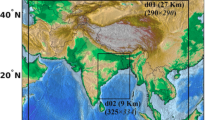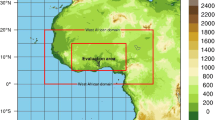Abstract
This study evaluates the characteristics of systematic errors (up to day 4) in the planetary boundary layer (PBL) parameterization schemes over the state of Odisha and its neighboring regions for two contrasting monsoon seasons, i.e., 2013 (normal) and 2014 (deficit), using the Weather Research and Forecasting (WRF) model. A total of 1112 numerical experiments are carried out, each with initial conditions from May 28 to September 29 using four PBL schemes, i.e., Yonsei University (YSU), Mellor-Yamada-Nakanishi-Niino (MYNN), Asymmetric Convective Model version 2 (ACM2), and Medium Range Forecast (MRF) with horizontal resolutions of 27 and 9 km with a lead time up to 96 h. It is found that the PBL parameterizations significantly impact the basic atmospheric variables (i.e., wind, temperature, moisture, and rainfall) and associated convective processes such as moist static energy. The wind and rainfall forecast skill of MRF showed better agreement with European Re-Analysis (ERAI). However, YSU has better skills for 2-m temperature and specific humidity compared to others. All PBL schemes produced a moist bias at the surface except MRF. The principle cause of this moist bias with mid tropospheric warming is attributed to inherent tendency of the model to overestimate moist static energy leading to intense vertical motion and convective instability. The magnitude of errors for wind forecast is higher for the deficit year compared to the normal monsoon year. However, the strength of the cross equatorial flow is found to be weaker in all the experiments for both the seasons. In general, the spread and magnitude of errors are large for 2013 (normal) as compared to 2014 (deficit) year.










Similar content being viewed by others
References
Baisya H, Pattnaik S, Rajesh PV (2017) Land surface-precipitation feedback analysis for a landfalling monsoon depression in the Indian region. J Adv Model Earth Syst 9:712–726. https://doi.org/10.1002/2016MS000829
Banta, R.M, Y. L., Pichugina and R K Newsom (2003) Relationship between low-level jet properties and turbulence Kinetic Energy in the nocturnal stable boundary layer, Jour. of Atmospheric Sciences, 60,2529-2555.
Basu S, Iyengar GR, Mitra AK (2002) Impact of a nonlocal closure scheme in a simulation of a monsoon system over India. Mon Weather Rev 130:161–170
Borge R, Alexandrov V, José del Vas J, Lumbreras J, Rodríguez E (2008) A comprehensive sensitivity analysis of the WRF model for air quality applications over the Iberian Peninsula. Atmos Environ 42:8560–8574
Collins WD et al (2004) Description of the NCAR Community Atmosphere Model (CAM 3.0). NCAR Tech. Note NCAR/TN–464+STR, 214
Das S, Mitra AK, Iyengar GR, Mohandas S (2001) Comprehensive test of different cumulus parameterization schemes for the simulation of the Indian summer monsoon. Meteorog Atmos Phys 78:227–244
Gadgil S, Gadgil S (2006) The Indian Monsoon, GDP and agriculture. Econ Polit Weekly 41(47):4887–4895
García Diez M, Fernández J, Fitaand L, Yague C (2013) Seasonal dependence of WRF model biases and sensitivity to PBL schemes over Europe. Q J R Meteorol Soc 139:501–514
Garratt JR (1994) The atmospheric boundary layer. Cambridge University Press 316
Gunwani P, Mohan M (2017) Sensitivity of WRF model estimates to various PBL parameterizations in different climatic zones over India. J Atmos Res 194:43–65
Hariprasad KBRR, Srinivas CV, Singh AB, Rao SVB, Baskaran R, Venkatraman B (2014) Numerical simulation and inter-comparison of boundary layer structure with different PBL schemes in WRF using experimental observations at a tropical site. Atmos Res 145–146:27–44
Hong, Noh Y, Dudhia J (2006) A new vertical diffusion package with explicit treatment of entrainment processes. Mon Weather Rev 134:2318–2341
Hu XM, Nielsen-Gammon JW, Zhang F (2010) Evaluation of three planetary boundary layer schemes in the WRF model. J Appl Meteorol Climatol 49:1831–1844
Hong, S. and Lim, J. (2006) The WRF Single-Moment 6-Class Microphysics Scheme (WSM6). Journal of the Korean Meteorological Society, 42,129-151.
Hong S-Y, Pan H-L (1996) Nonlocal boundary layer vertical diffusion in a medium-range forecast model.Mon Weather Rev 124:2322–2339.
India Meteorological Department (2013) Monsoon 2013 A Report, ESSO Document No.: Synoptic Meteorology No.: ESSO/IMD/SYNOPTIC MET/ 01-2014/15, Edited by D .S Pai and S. C Bhan http://www.imd.gov.in/section/nhac/monsoon_report_2013.pdf. Accessed 29 July 2018
India Meteorological Department (2014) Monsoon 2014 A Report, ESSO Document No.: ESSO Document No.: ESSO / IMD / SYNOPTIC MET / 01(2015)/17, Edited by D .S Pai and S. C Bhan http://www.imd.gov.in/section/nhac/monsoon_report_2014.pdf. Accessed 29 July 2018
Jimenez PA, Dudhia J (2013) On the Ability of the WRF Model to Reproduce the Surface Wind Direction over Complex Terrain. J Appl Meteorol Climatol 52:1610–1617
Jimenez P, Jorba O, Parra R, Baldasano JM (2006) Evaluation of MM5-EMICAT2000-CMAQ performance and sensitivity in complex terrain: High resolution application to the north-eastern Iberian Peninsula. Atmos Environ 40:5056–5072
Kain JS (2004) The Kain–Fritsch convective parameterization: An update. J Appl Meteorol 43:170–181
Madala S, Satyanarayana ANV, Rao TN (2014) Performance evaluation of PBL and cumulus parameterization schemes of WRF ARW model in simulating severe thunderstorm events over Gadanki MST radar facility — case study. Atmos Res 139:1–17
Martin GM, Soman MK (2000) Effects of changing physical parameterization schemes on the simulation of the Asian summer monsoon in the UK Met Office unified model. Hadley Centre Tech Note HCTN17:48
Mellor GL, Yamada T (1982) Development of a turbulence closure model for geophysical fluid problems. Rev Geophys 20:851–875
Mishra V, Smoliak BV, Lettenmaier DP, Wallace (2012) J MA prominent pattern of year-to-year variability in Indian Summer Monsoon Rainfall. Proc Natl Acad Sci U S A 109:7213–7217
Mitra AK, Momin IM, Rajagopal EN, Basu S, Rajeevan MN, Krishnamurti TN (2013) Gridded daily Indian monsoon rainfall for 14 seasons: Merged TRMM and IMD gauge analyzed values. J Earth Syst Sci 122:1173–1182
Mohan M, Bhati S (2011) Analysis of WRF model performance over subtropical region of Delhi, India. Adv Meteorol 1–13
Mohapatra M, Mohanty UC, Behera S (2003) Spatial variability of daily rainfall over Orissa, India, during the southwest summer monsoon season. J Climatol 23:1867–1887
Nakanishi M, Niino H (2006) An improved Mellor–Yamada level 3 model: its numerical stability and application to a regional prediction of advecting fog. Bound-Layer Meteorol 119:397–407
Nakanishi, M., and H. Niino, 2004: An improvedMellor-Yamada level-3 model with condensationphysics: its design and verification.Bound.-LayerMeteor.,112, 1–31.
Nakanishi, M., and H. Niino, 2009: Development of animproved turbulence closure model for the atmo-spheric boundary layer.J. Meteor. Soc. Japan,87,895–912.
Paulson CA (1970) The mathematical representation of wind speed and temperature profiles in the unstable atmospheric surface layer. J Appl Meteorol 9:857–861
Pleim JE (2007a) A combined local and nonlocal closure model for the atmospheric boundary layer, Model description and testing. J Appl Meteorol Climatol 46:1383–1395
Pleim (2007b) A combined local and nonlocal closure model for the atmospheric boundary layer, Application and evaluation in a mesoscale meteorological model. J Appl Meteorol Climatol 46:1396–1409
Pleim, J. E., and J. S. Chang, 1992: A non-local closure model for vertical mixing in the convective boundary layer. Atmos. Environ., 26A, 965–981.
Rai D, Pattnaik S (2018) Sensitivity of Tropical Cyclone Intensity and Structure to Planetary Boundary Layer Parameterization. Asia-Pac J Atmos Sci 54(3):473–488
Rai D, Pattnaik S (2019) Evaluation of WRF planetary boundary layer parameterization schemes for simulation of monsoon depressions over India. Meteorog Atmos Phys 131(5):1529–1548. https://doi.org/10.1007/s00703-019-0656-3
Saha SK, Pokhrel S, Chaudhari HS (2013) Influence of Eurasian snow on Indian summer monsoon in NCEP CFSv2 freerun. Clim Dyn 41:1801–1815
Samanta D, Dash MK, Goswami BN, Pandey PC (2015) Extra-tropical anti-cyclonic Rossby wave breaking and Indian summer monsoon failure. Clim Dyn 46:1547–1562
Sathyanadh A, Thara VP, Balaji B, Reshmi EA, Karipot A (2017) Evaluation of WRF PBL parameterization schemes against direct observations during a dry event over the Ganges valley. Atmos Res 193:125–141
Shin HH, Hong SY (2011) Inter-comparison of planetary boundary-layer parametrizations in the WRF model for a single day from CASES-99. Bound-Layer Meteorol 139:261–281
Sisodiya A, Pattnaik S, Baisya H, Bhat GS, Turner A (2019) Simulation of location-specific severe thunderstorm events using high resolution land data assimilation. Dyn Atmos Ocean. https://doi.org/10.1016/j.dynatmoce.2019.101098
Skamarock WC (2004) Evaluating mesoscale NWP models using kinetic energy spectra. Mon Weather Rev 132:3019–3032
Sperber KR, Palmer TN (1996) Inter-annual tropical rainfall variability in general circulation model simulations associated with the Atmospheric Model Inter-comparison Project. J Clim 9:2727–2750
Srikanth M, Satyanarayana ANV, Srinivas CV, Kumar M (2015) Mesoscale atmospheric flow-field simulations for air quality modelling over complex terrain region of Ranchi in eastern India using WRF. Atmos Environ 107:315–328
Srinivas CV, Venkatesan R, Bagavath Singh A (2007) Sensitivity of mesoscale simulations of land-sea breeze to boundary layer turbulence parameterization. Atmos Environ 41:2534–2548
Storm B, Dudhia J, Basu S, Swift A, Giammanco I (2009) Evaluation of the Weather Research and Forecasting model on forecasting low-level jets: Implications for wind energy. Wind Energy 12:81–90
Stull RB (1988) An introduction to boundary layer meteorology. Kluwer Academic Publishers, Dordrecht, Boston, London 666
Tewari M, Chen, F, Wang W, Dudhia J, Le Mone MA, Mitchell K, Ek M, Gayno G, Wegiel J, and Cuenca RH (2004) Implementation and verification of the unified NOAH land surface model in the WRF model. 20th conference on weather analysis and forecasting/16th conference on numerical weather prediction. 11–15
Wang ZQ, Duan AM, Wu GX (2014) Impacts of boundary layer parameterization schemes and air-sea coupling on WRF simulation of the East Asian summer monsoon. Sci China Earth Sci 57:1480–1493
Xie B, Fung JCH, Chan A, Lau A (2012) Evaluation of nonlocal and local planetary boundary layer schemes in the WRF model. J Geophys Res 117:D12103. https://doi.org/10.1029/2011JD017080
Acknowledgments
The authors would like to thank Indian Institute of Technology Bhubaneswar for providing us all the research facilities and helpful assistance required for this purpose. The authors thankfully acknowledge visualization tool GrADS (Grid Analysis and Display System) which is default free software by Linux community, National Centre for Environment Prediction (NCEP-FNL), European Centre for Medium range Weather Forecasting (ECMWF) and India Meteorological Department (IMD) for providing us all those data sets required for the initialization and validation of the WRF model.
Funding
The Indian Space Research Organization (ISRO), Scientific and Engineering Research Board (SERB), and Department of Science and Technology, Government of India provided the financial assistance in terms of research grants (RP-063, RP-132, RP-193) for carrying out this work.
Author information
Authors and Affiliations
Corresponding author
Additional information
Publisher’s note
Springer Nature remains neutral with regard to jurisdictional claims in published maps and institutional affiliations.
Electronic supplementary material
ESM 1
(DOCX 1655 kb)
Rights and permissions
About this article
Cite this article
Hazra, V., Pattnaik, S. Systematic errors in the WRF model planetary boundary layer schemes for two contrasting monsoon seasons over the state of Odisha and its neighborhood region. Theor Appl Climatol 139, 1079–1096 (2020). https://doi.org/10.1007/s00704-019-03023-3
Received:
Accepted:
Published:
Issue Date:
DOI: https://doi.org/10.1007/s00704-019-03023-3




